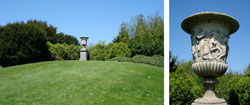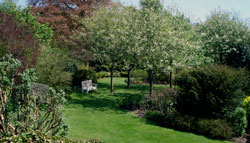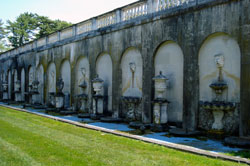Welcome to our newest venture: Barbara Israel Garden Antiques: Focal Points!
Garden ornament is a medium that has enchanted generations for hundreds of years. Our goal in this publication is to bring you more information about ornaments and the gardens they enliven, with the hope that our enthusiasm will spark your own passion for looking, collecting, and making your garden a personal wonderland. Look for Focal Points in your email box six times a year.

The Urn as a Single Garden Feature
By Barbara IsraelWhen I visited Uppark House in Petersfield, West Sussex, England last May I found the most impressive feature to be a single grand urn on top of a hillside. The setting was spectacular. As I stood at the bottom of the slope looking up at the urn I felt compelled to walk toward it. I wanted to see the details and experience standing next to it. How large was it? What were the figures on it? The placement of this single classical ornament in front of a medley of evergreen and other shrubs made the hillside look imposing while, at the same time, it beckoned me forward piquing my fascination and curiosity.
In the 21st century we don’t often think of using just a single piece like this to stand out in the landscape but for years it has been a well-recognized stylistic ploy. The English picturesque garden style adopted the use of a single commemorative urn in the 18th century. In the 1840s Andrew Jackson Downing, the first American landscape specialist, positively extolled the use of the urn, or as he called it “vase”, in the garden. Note that such urns were kept unplanted thereby saving the owner from the responsibility of watering! Today we tend to think of urns in pairs for either side of an entrance or a walkway but a large single urn will do very well at the end of an allée or at the intersection of two garden paths. Whether your garden is geometric or free-form in style I suggest you consider placing an urn as a focal point thereby adding a traditional dimension to your garden.
Reveries from Running Duck Farm: New Plants for Spring
By Nan Zander
The Winter Solstice keeps me going in the darkest days of winter. As glowing white flakes fall silently outside my window, that extra minute of daylight tacked on to the end of every cold day makes it all okay. It’s the light at the end of the tunnel. The other bright spots after the holidays are the seed and plant catalogues that arrive each day, bringing the warm promise of spring. There is no better reading material on these cold snowy days than the catalogues, with every vibrant page filling my head with thoughts and plans for the coming season. Among the beauties currently available in catalogues and online, the following stood out in the first round of my personal competition.
Flowering tobacco Nicotiana x sanderae “Cranberry Isle” is a newly available heirloom variety that produces fragrant trumpets ranging in hue from white through pinks, mauves, lilacs and dark purples. Nicotiana is poisonous, but is an abundant self-sower. I have a bed of chartreuse flowering tobacco that has been self-sowing for years and comes back stronger and fuller each year. “Cranberry Isle” is sold as an exclusive in the Select Seed catalogue.

The Slipper flower Calceolaria Falklandica is an adorable alpine that is new to me, although it is available online at various rare plant specialists. If you live in zones 7 through 9 (the USDA Hardiness map is a wonderful thing), you can grow this little gem as a perennial and it should “naturalize freely”. It is a yellow variety of the Slipper Flower that is otherwise available in much too vibrant combinations of oranges and yellows. It is perfect for my woodland gardens. Perhaps one reason I love this Calceolaria is that it reminds me of the yellow lady slipper orchids that grew behind my girlhood home. Though unrelated to the Cypripediums of my youth, it is a cheery pretender at a much more affordable price than the native orchids currently available at high end nurseries. It is new at Park Seeds, where it is offered as a plant for spring shipment.
I am a pushover for the deep maroon color known as “black” in the flower world. This color has been known to bedazzle me into buying things that I shouldn’t, but I am powerless in its presence. The Hollyhock nigra “Black Beauty” is a perfect example. So is the Siberian Iris chrysographes; and the Louisiana Iris “Black Gamecock”. Chartreuse is another color I can’t resist, and one that works with cut flowers of any color. The zinnia “Tequila Lime” is even greener than the popular “Envy” that hit the market a few years ago and I hope to find it available in flats at Claire’s, my favorite local nursery (in Putnam County, NY). Lastly, the foxglove Digitalis purpurea “Candy Mountain”, new at White Flower Farm, is a gorgeous new variety with abundant upward facing cones that give a whole new look to one of my favorite flowers. I envision a naturalized mass of this cheerful pink charmer under the bridal veil Spirea in the backyard where my foxgloves thrive.
Back to my chair by the fire. Even though the days are getting longer, there still aren’t enough hours to dream about gardens. Until next time.
Photo credit: www.parkseed.com

Uppark
By Katy Keiffer
Uppark, a recent stop for Barbara, is located in West Sussex overlooking the Solent River, the Harting Down, the sea and the Isle of Wight. Aside from the magnificent residence, meticulously restored after a devastating fire in 1989, the estate boasts 54 acres of spectacular gardens and woodland park. In addition it maintains a viable farm.
The property was owned by the 1st Earl of Tankerville at the time that the original gardens were laid out in 1690 by George London, Royal Gardener, and close collaborator of William Talman. This team was also responsible for the nearby, and better known, Petworth House. Later, there is speculation that “Capability” Brown participated as a consulting designer in the 1750s following Sir Matthew Featherstonhaugh’s acquisition of the estate. However, at the behest of his heir Sir Harry Featherstonhaugh, the gardens were updated in the early 19th century to their current design by Humphrey Repton, who also designed the gardens at Woburn. The current selection of plants remains very true to Repton’s original plan.
Uppark was donated by the Featherstonhaugh family heirs to the National Trust in 1954 and is open to the public March through October, with a brief opening in December for the holidays. There are garden tours the first Thursday of every month, and every Thursday in July and August. For more information, this link will direct you to Uppark House and Garden on the National Trust website.

Longwood Gardens
By Katy Keiffer
Longwood Gardens in Kennett Square, PA, has one of the largest selections of garden ornament and fountains in the United States. On a recent excursion, Barbara photographed several of the stonework features including a wall that uses urns as a primary decorative element. Owner Pierre duPont was so enchanted with the form that he commissioned a series of urns alternating with shells and basins to decorate the 200-foot-long expanse of the Pumphouse Facade.
According to Longwood Historian, Colvin Randall, the extraordinary fountain displays were largely designed and plumbed by duPont himself, no idle millionaire. With his chief electrician Phil Brewer, duPont mapped out the fountains and their plumbing while Brewer wired them for the timing of the displays. Much of the inspiration for the water gardens came from his travels to gardens in Italy and France. For example, upon seeing the Villa D’Este and the Avenue of 100 Fountains, duPont remarked to his brother that “It would be nice to have something like this at home” (!!). Subsequently he built his own version, The Upper Canal. The Italian Water Gardens were modeled after those at the Villa Gamberaia, near Florence.

Most of the ornamental fountain work created between 1925 and 1935 can be attributed to the Morseletto studios in Florence (now in Vicenza). Pierre duPont and Piero Morseletto maintained a long association, with duPont giving financial assistance to the Morseletto business allowing it to survive the Great Depression.
The colored lights with which the fountains are displayed at night are a direct result of duPont’s enthusiasm for the fountain displays he saw at the various World’s Fairs in the United States and Europe in the late 19th century. The Columbian Exposition of 1893 was particularly inspirational as it showcased how electricity, the new technology, could be used for dramatic effects. Since then, not much has changed in the methodology, and such designs as those of duPont and Brewer remain templates for such new fountain installations as those at Bellagio in Las Vegas.
Though an arboretum was already in place when duPont purchased the property, according to Randall, much of the original land was cornfields, remnants of the original Pierce farm. To realize his dream, duPont planted hundreds of mature trees to achieve a green backdrop for his fountains so they could be viewed during the day as effectively as against the night sky.
Among the many treasures at Longwood, visitors should be sure to visit the “whispering bench”, a beautiful curved bench at the end of the Flower Garden Walk. It is said that sitting on opposite ends of the bench, it is possible to hear even a whisper as clearly as a regular speaking voice.
Longwood Gardens is open to the public from May through October. Special events: The Orchid Extravaganza, January 24 – March 31 and Spring Blooms, April 1 – May 22. More information can be found on their website, www.longwoodgardens.org.
————————
Look for future newsletters about maintenance, plants, ornaments, gardens to visit and more, hope you enjoy it,